
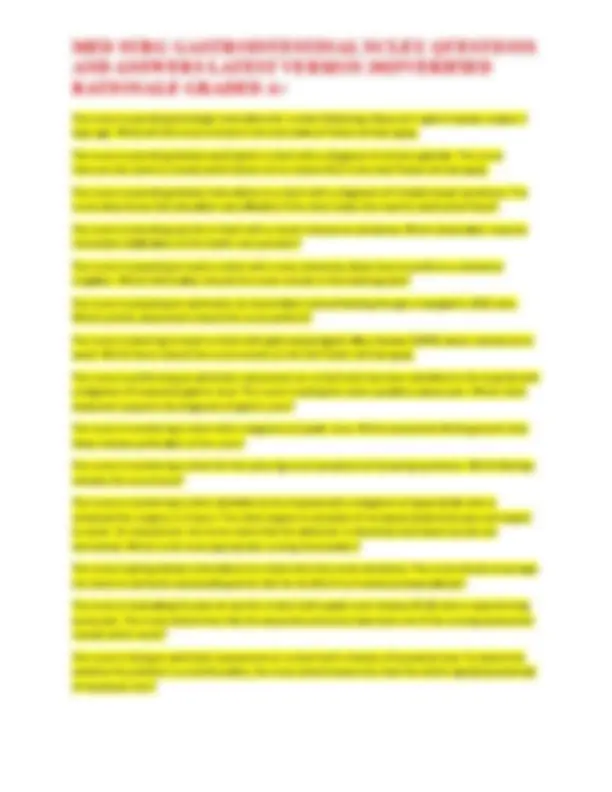
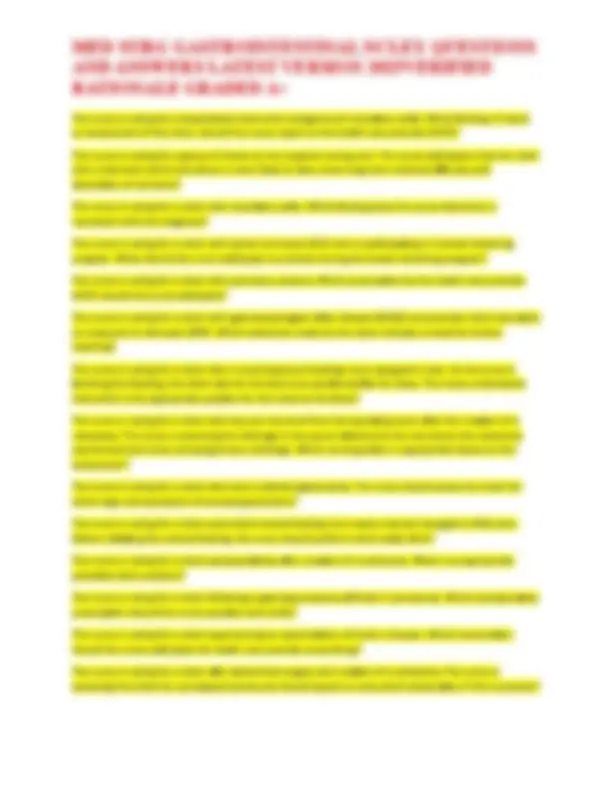
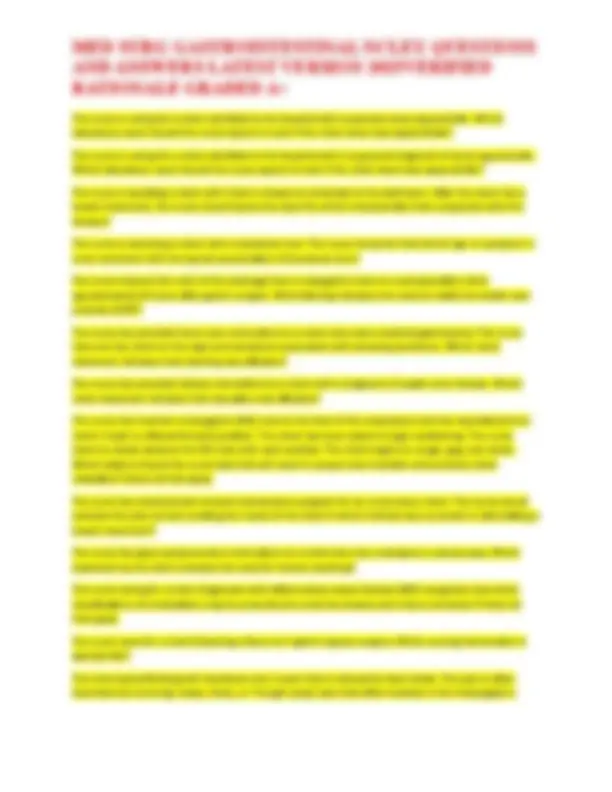
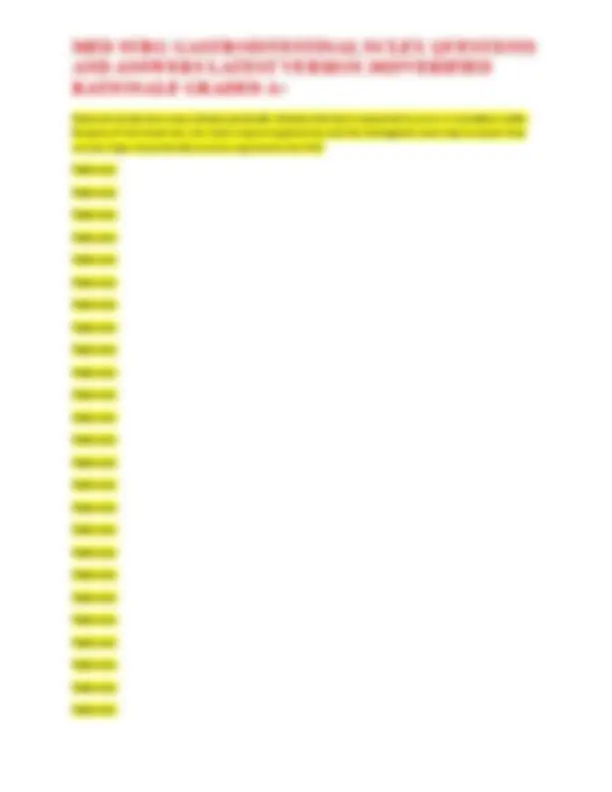
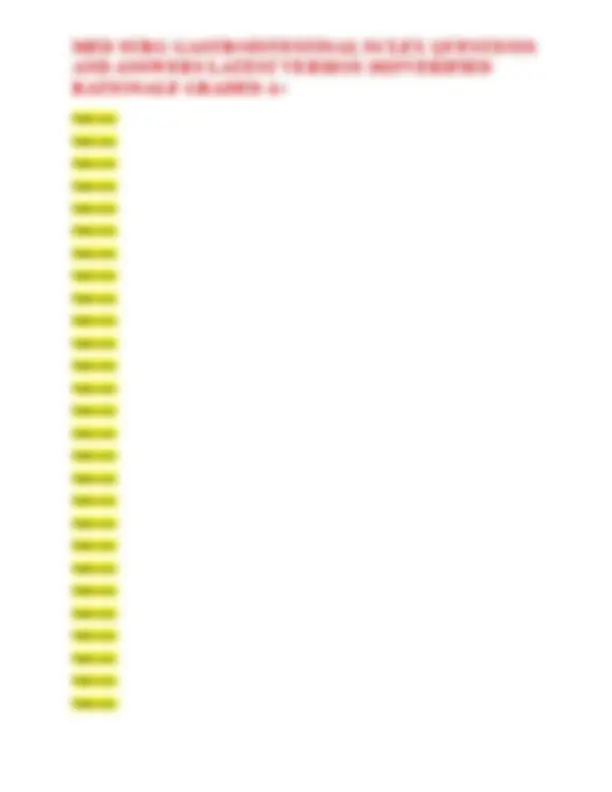
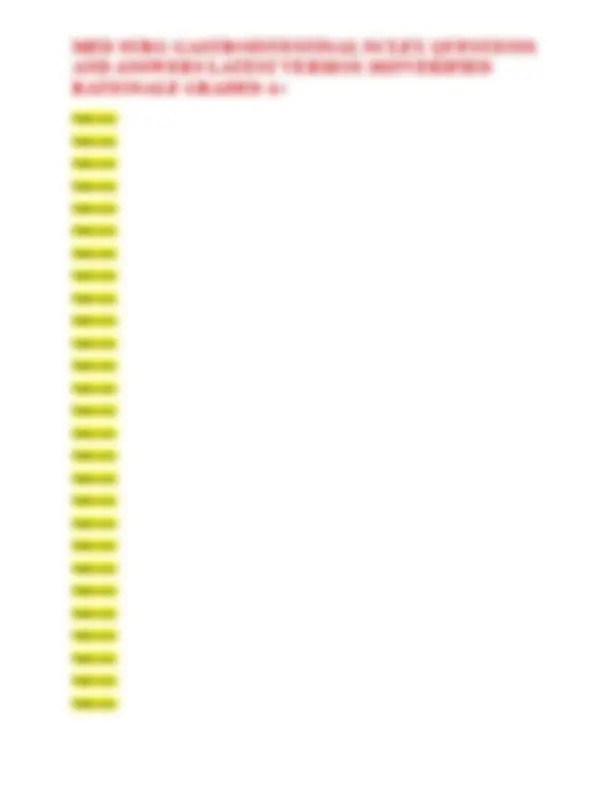
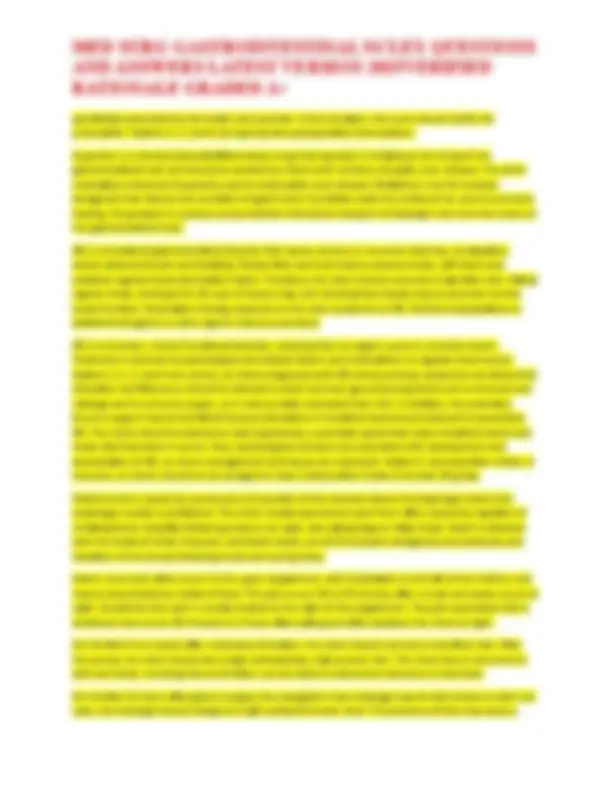

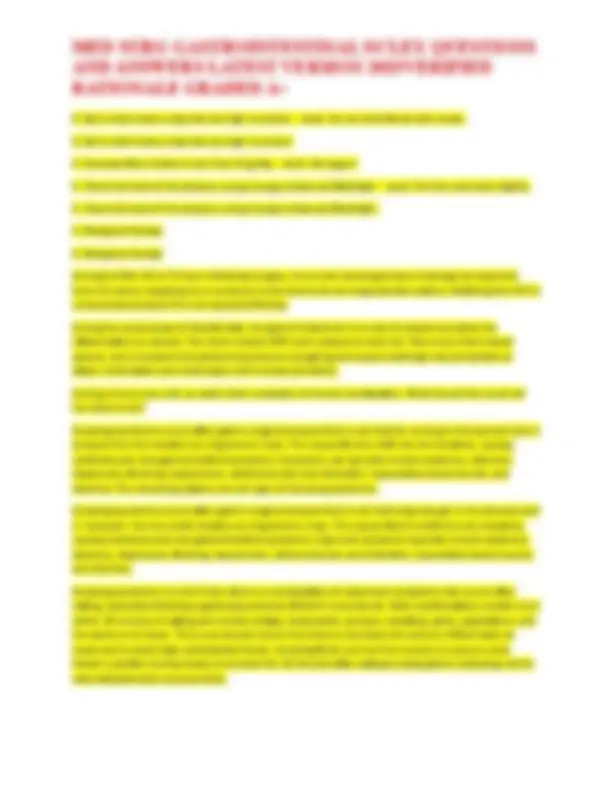
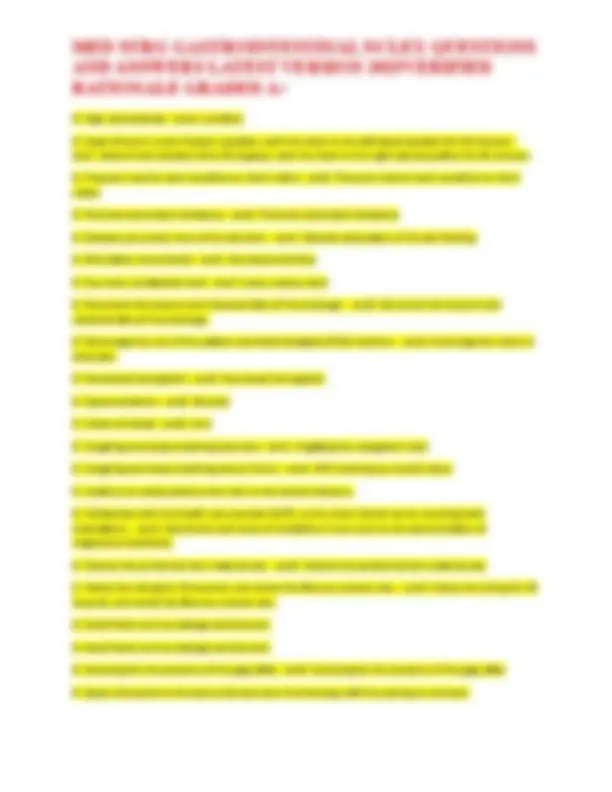
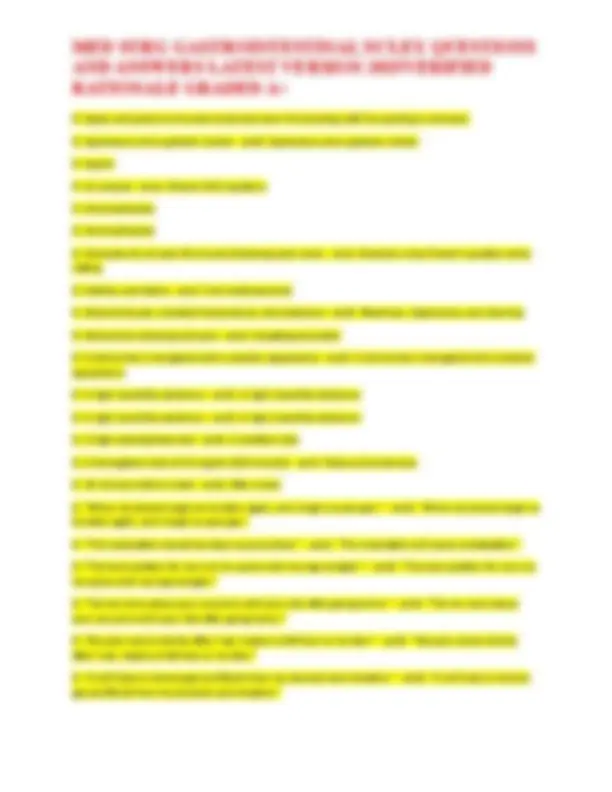
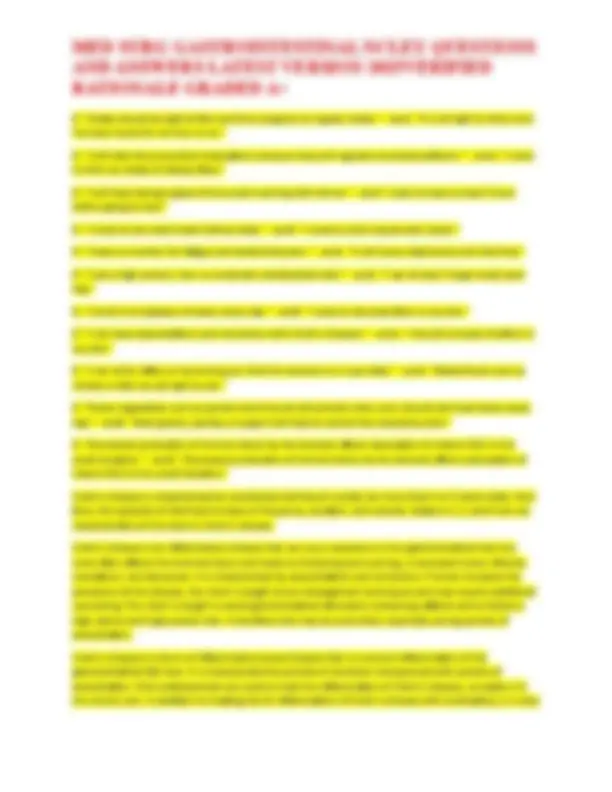
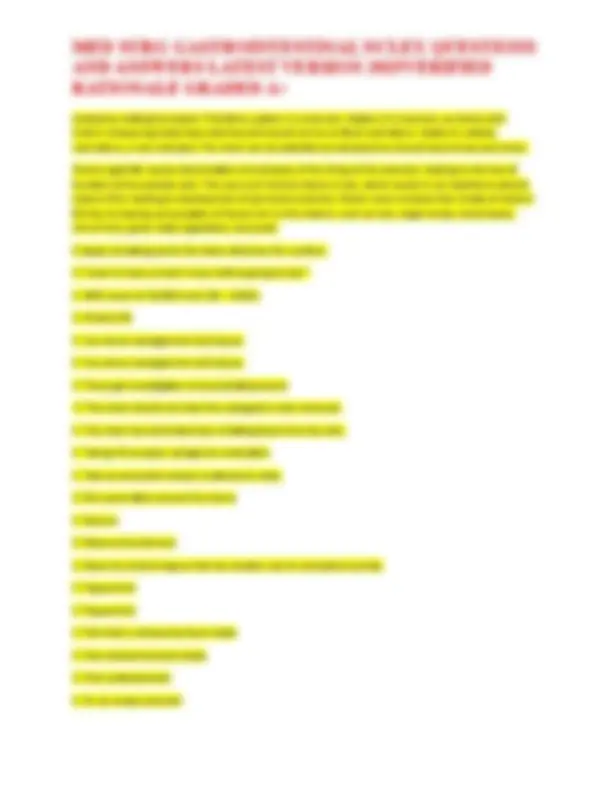
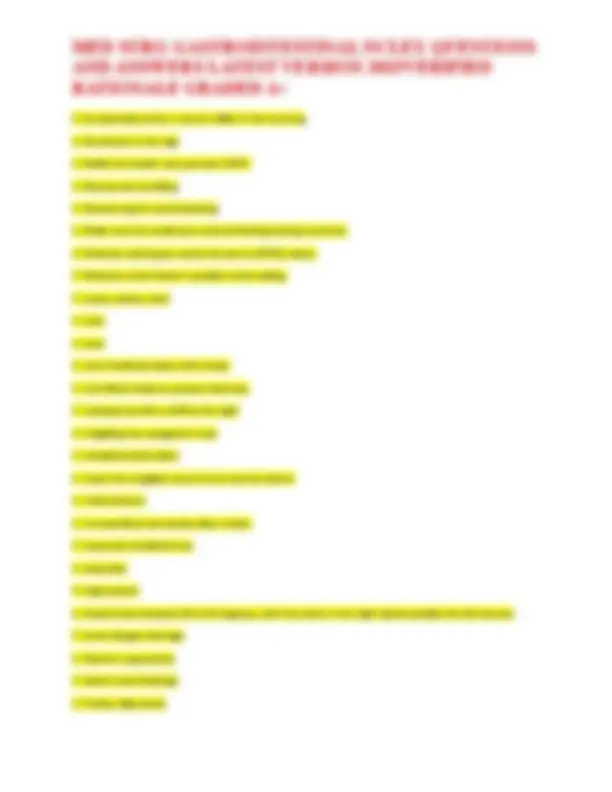
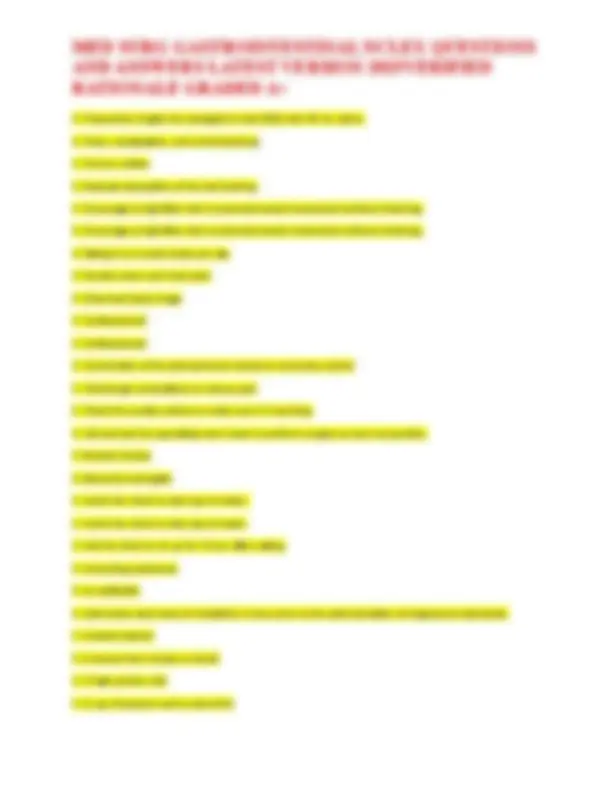
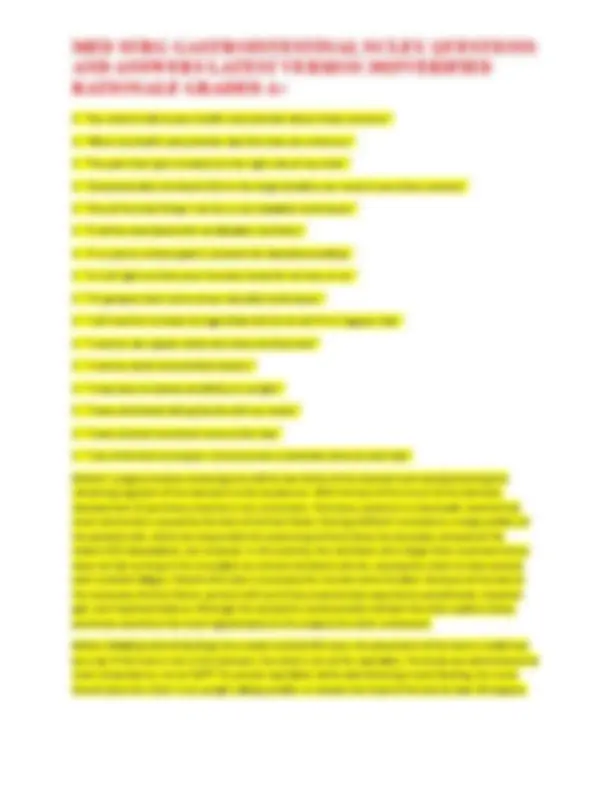
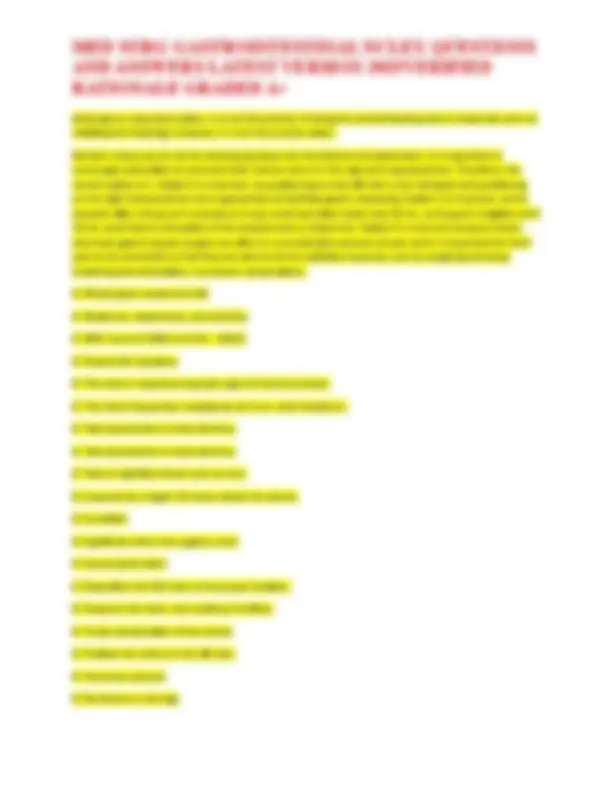
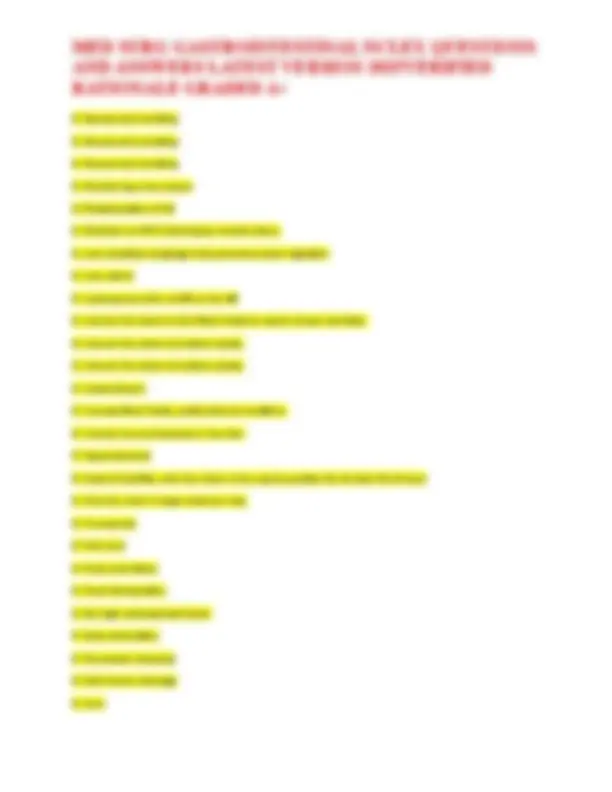

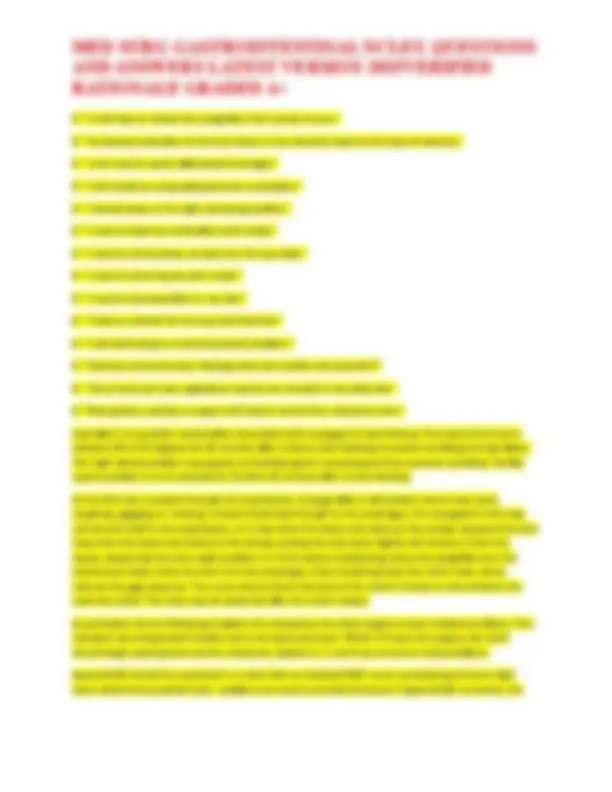
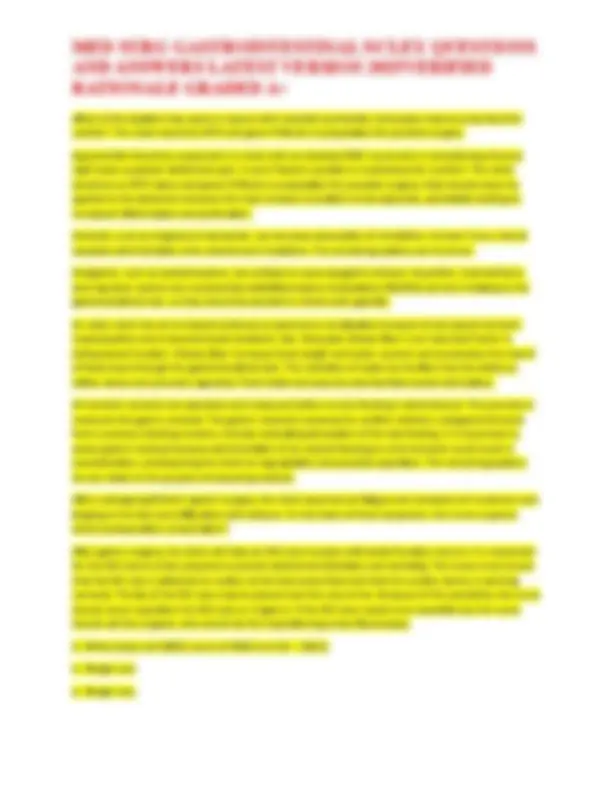
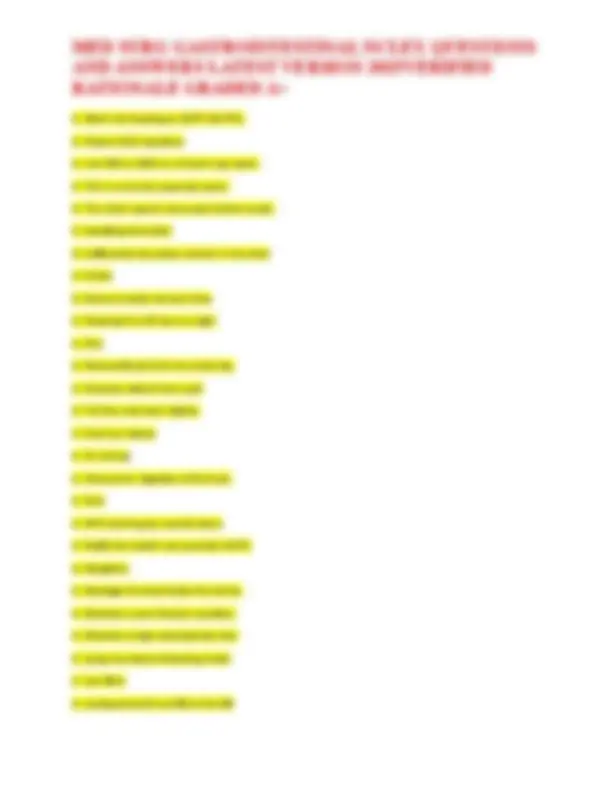
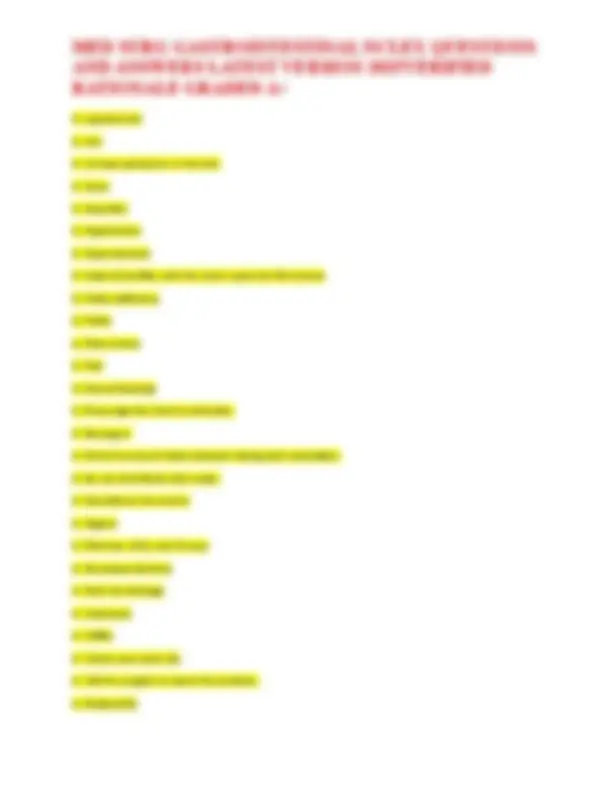
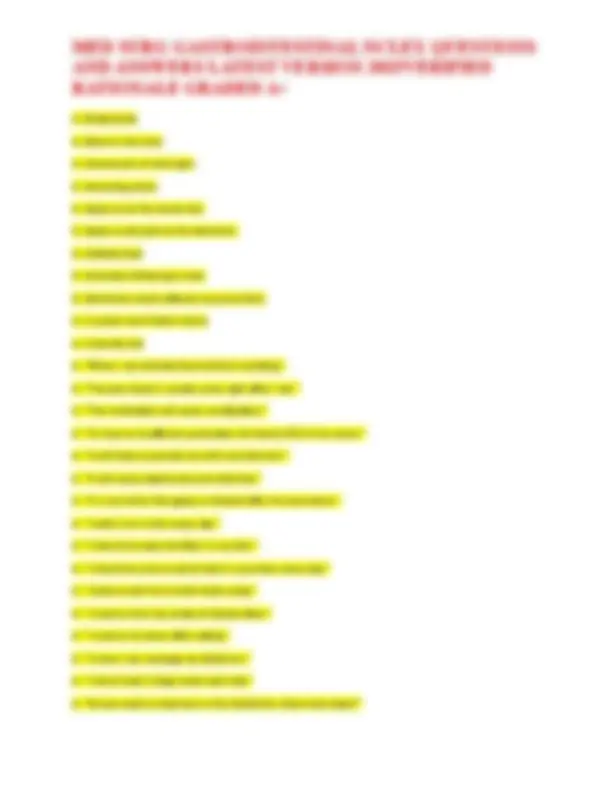
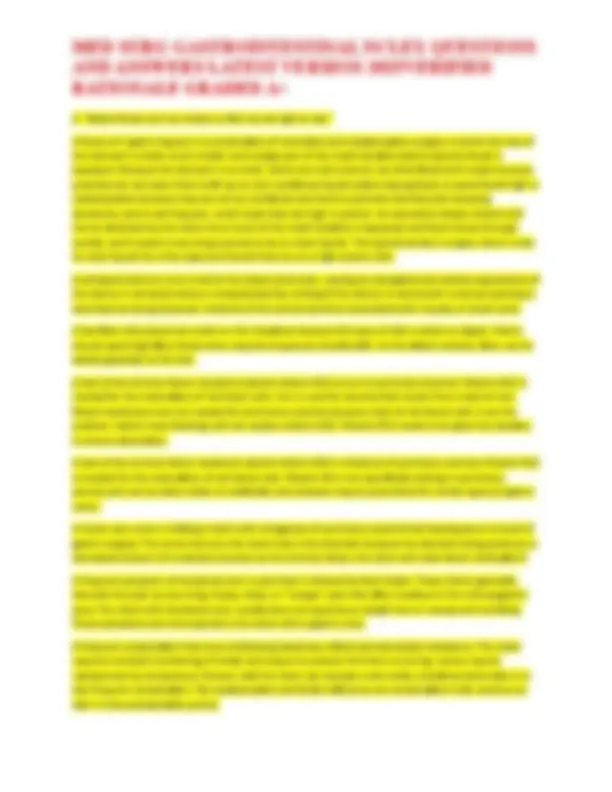
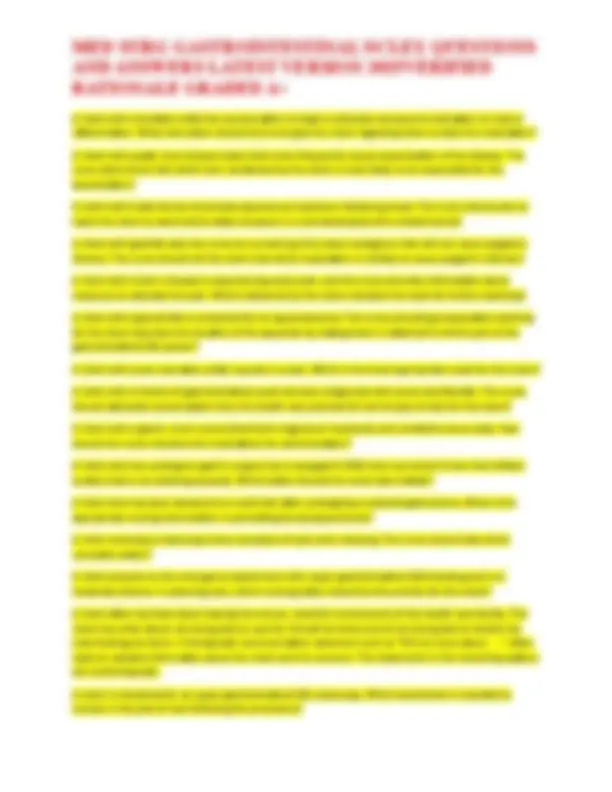
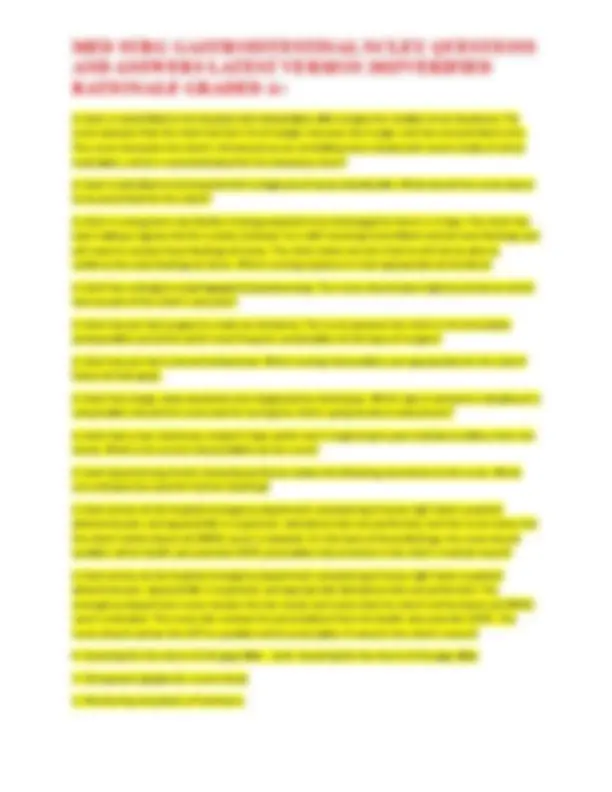












Study with the several resources on Docsity

Earn points by helping other students or get them with a premium plan


Prepare for your exams
Study with the several resources on Docsity

Earn points to download
Earn points by helping other students or get them with a premium plan
Community
Ask the community for help and clear up your study doubts
Discover the best universities in your country according to Docsity users
Free resources
Download our free guides on studying techniques, anxiety management strategies, and thesis advice from Docsity tutors
MED SURG GASTROINTESTINAL NCLEX QUESTIONS AND ANSWERS LATEST VERSION 2025 VERIFIED RATIONALE GRADED A+.pdf
Typology: Exams
1 / 45

This page cannot be seen from the preview
Don't miss anything!






































Ulcerative colitis is an inflammatory disease of the large colon. Findings associated with ulcerative colitis include diarrhea with up to 10 to 20 liquid bloody stools per day, weight loss, anorexia, fatigue, increased white blood cell count, increased erythrocyte sedimentation rate, dehydration, hyponatremia, and hypokalemia (not hypercalcemia). Because of the loss of blood, clients with ulcerative colitis commonly have decreased hemoglobin and hematocrit levels. Clients with ulcerative colitis have bloody diarrhea, not steatorrhea (fatty, frothy, foul-smelling stools). Treatment of intestinal obstruction is directed toward decompression of the intestine by removal of gas and fluid. Nasogastric tubes may be used to decompress the stomach and bowel. Continuous gastric suction does not provide nourishment. The purpose of tracheal suctioning (not gastric suctioning) is to remove excess mucus that has led to congestion. Although gastric contents may be sent for laboratory analysis, it is not the main purpose for continuous gastric suction. The usual procedure for colostomy irrigation includes using 500 to 1000 mL of warm tap water. The solution is suspended 18 inches above the stoma. The cone is inserted 2 to 4 inches into the stoma but should never be forced. If cramping occurs, the client should decrease the flow rate of the irrigant as needed by closing the irrigation clamp. The small intestine is responsible for the absorption of most nutrients. The client who has undergone removal of a segment of the small bowel is the one who has a decreased area with which to absorb nutrients. Decreased absorption is not a likely complication with the surgical procedures identified in the remaining options. The registered nurse is precepting a new nurse who is caring for a client with pernicious anemia as a result of gastrectomy. Which statement made by the new nurse indicates understanding of this diagnosis? The priority nursing action is to assess the vital signs. This would indicate the amount of blood loss that has occurred and also provides a baseline by which to monitor the progress of treatment. The client may not be able to provide subjective data until the immediate physical needs are met. Although an abdominal examination and an assessment of the precipitating events may be necessary, these actions are not the priority. The principal reflex center for defecation is located in the parasympathetic center at the S1 to S4 level of the spinal cord. This center is most active after the first meal of the day. Other factors that contribute to satisfactory stool passage are sufficient fluid and roughage in the diet and the Valsalva maneuver (which is lost with SCI). During defecation, the anal sphincter relaxes. The peristomal skin must receive meticulous cleansing because ileostomy drainage has more enzymes and is more caustic to the skin than colostomy drainage. The area below the ileostomy may be massaged as needed if the ileostomy becomes blocked by high-fiber foods. Foods such as nuts and those with seeds will pass through the ileostomy. The client should be taught that these foods will remain undigested. Fluid intake should be at least 6 to 8 glasses of water per day to prevent dehydration.
The nurse teaches a preoperative client about the use of a nasogastric (NG) tube for the planned surgery. Which statement indicates to the nurse that the client understands when the tube can be removed in the postoperative period? The nurse should instruct a client with an ileostomy to include which action as part of essential care of the stoma? The nurse should anticipate that the health care provider (HCP) will prescribe which treatment for a client with pernicious anemia? The nurse provides instructions to a client about measures to treat inflammatory bowel syndrome (IBS). Which statement by the client indicates a need for further teaching? The nurse places highest priority on assessing for return of the gag reflex. This assessment addresses the client's airway. The nurse also monitors the client's vital signs and for a sudden increase in temperature, which could indicate perforation of the gastrointestinal tract. This complication would be accompanied by other signs as well, such as pain. Monitoring for sore throat and heartburn are also important; however, the client's airway is the priority. The nurse obtains an admission history for a client with suspected peptic ulcer disease (PUD). Which client factor documented by the nurse would increase the risk for PUD? The nurse is teaching the postgastrectomy client about measures to prevent dumping syndrome. Which statement by the client indicates a need for further teaching? The nurse is teaching an older client about measures to prevent constipation. Which statement by the client indicates a need for further teaching? The nurse is reviewing the medication record of a client with acute gastritis. Which medication, if noted on the client's record, should the nurse question? The nurse is providing instructions to a client with a colostomy about measures to reduce the odor from the colostomy. Which client statement indicates that the educational session was effective? The nurse is providing instructions to a client regarding measures to minimize the risk of dumping syndrome. The nurse should make which suggestion to the client? The nurse is providing instructions to a client diagnosed with irritable bowel syndrome (IBS) who is experiencing abdominal distention, flatulence, and diarrhea. What interventions should the nurse include in the instructions? Select all that apply. The nurse is providing discharge teaching for a client with newly diagnosed Crohn's disease about dietary measures to implement during exacerbation episodes. Which statement made by the client indicates a need for further instruction? The nurse is providing discharge instructions to a client following gastrectomy and should instruct the client to take which measure to assist in preventing dumping syndrome?
The nurse is caring for a hospitalized client with a diagnosis of ulcerative colitis. Which finding, if noted on assessment of the client, should the nurse report to the health care provider (HCP)? The nurse is caring for a group of clients on the surgical nursing unit. The nurse anticipates that the client who underwent which procedure is most likely to have some long-term residual difficulty with absorption of nutrients? The nurse is caring for a client with ulcerative colitis. Which finding does the nurse determine is consistent with this diagnosis? The nurse is caring for a client with spinal cord injury (SCI) who is participating in a bowel retraining program. What should the nurse anticipate to promote during the bowel retraining program? The nurse is caring for a client with pernicious anemia. Which prescription by the health care provider (HCP) should the nurse anticipate? The nurse is caring for a client with gastroesophageal reflux disease (GERD) and provides client education on measures to decrease GERD. Which statement made by the client indicates a need for further teaching? The nurse is caring for a client who is receiving bolus feedings via a nasogastric tube. As the nurse is finishing the feeding, the client asks for the bed to be positioned flat for sleep. The nurse understands that which is the appropriate position for this client at this time? The nurse is caring for a client who has just returned from the operating room after the creation of a colostomy. The nurse is assessing the drainage in the pouch attached to the site where the colostomy was formed and notes serosanguineous drainage. Which nursing action is appropriate based on this assessment? The nurse is caring for a client who had a subtotal gastrectomy. The nurse should assess the client for which signs and symptoms of dumping syndrome? The nurse is caring for a client prescribed enteral feeding via a newly inserted nasogastric (NG) tube. Before initiating the enteral feeding, the nurse should perform which action first? The nurse is caring for a client postoperatively after creation of a colostomy. What is an appropriate potential client problem? The nurse is caring for a client following a gastrojejunostomy (Billroth II procedure). Which postoperative prescription should the nurse question and verify? The nurse is caring for a client experiencing an exacerbation of Crohn's disease. Which intervention should the nurse anticipate the health care provider prescribing? The nurse is caring for a client after abdominal surgery and creation of a colostomy. The nurse is assessing the client for a prolapsed stoma and should expect to note which observation if this is present?
The nurse is caring for a client admitted to the hospital with suspected acute appendicitis. Which laboratory result should the nurse expect to note if the client does have appendicitis? The nurse is caring for a client admitted to the hospital with a suspected diagnosis of acute appendicitis. Which laboratory result should the nurse expect to note if the client does have appendicitis? The nurse is assisting a client with Crohn's disease to ambulate to the bathroom. After the client has a bowel movement, the nurse should assess the stool for which characteristic that is expected with this disease? The nurse is assessing a client with a duodenal ulcer. The nurse interprets that which sign or symptom is most consistent with the typical presentation of duodenal ulcer? The nurse inspects the color of the drainage from a nasogastric tube on a postoperative client approximately 24 hours after gastric surgery. Which finding indicates the need to notify the health care provider (HCP)? The nurse has provided home care instructions to a client who had a subtotal gastrectomy. The nurse instructs the client on the signs and symptoms associated with dumping syndrome. Which client statement indicates that teaching was effective? The nurse has provided dietary instructions to a client with a diagnosis of peptic ulcer disease. Which client statement indicates that education was effective? The nurse has inserted a nasogastric (NG) tube to the level of the oropharynx and has repositioned the client's head in a flexed-forward position. The client has been asked to begin swallowing. The nurse starts to slowly advance the NG tube with each swallow. The client begins to cough, gag, and choke. Which actions should the nurse take that will result in proper tube insertion and promote client relaxation? Select all that apply. The nurse has implemented a bowel maintenance program for an unconscious client. The nurse would evaluate the plan as best meeting the needs of the client if which method was successful in stimulating a bowel movement? The nurse has given postprocedure instructions to a client who has undergone a colonoscopy. Which statement by the client indicates the need for further teaching? The nurse caring for a client diagnosed with inflammatory bowel disease (IBD) recognizes that which classifications of medications may be prescribed to treat the disease and induce remission? Select all that apply. The nurse cares for a client following a Roux-en-Y gastric bypass surgery. Which nursing intervention is appropriate? The most typical finding with duodenal ulcer is pain that is relieved by food intake. The pain is often described as a burning, heavy, sharp, or "hunger pang" pain that often localizes in the midepigastric
hypovolemic shock develops. Nausea and vomiting may not occur if the pyloric sphincter is intact. Numbness in the legs is not an associated finding. The client should not drive for several hours after discharge because of the sedative medications used during the procedure. Important decisions also should be delayed for at least 12 to 24 hours for the same reason. The client may experience gas, bloating, or abdominal tenderness for a short while after the procedure, and this is normal. The client should resume intake slowly and progress as tolerated. The client should be taught to include deodorizing foods in the diet, such as beet greens, parsley, buttermilk, and yogurt. Spinach also may reduce odor, but it is a gas-forming food and should be avoided. Cucumbers, eggs, and broccoli also are gas-forming foods and should be avoided or limited by the client. The client at risk for dumping syndrome should be instructed to maintain a low Fowler's position while eating and lie down for at least 30 minutes after eating. The client also should be told that small, frequent meals are best and to avoid liquids with meals. Avoiding high-carbohydrate food sources also will assist in minimizing dumping syndrome. The appendix, sometimes referred to as the vermiform appendix, is attached to the apex of the cecum. The other locations listed are incorrect. Sulfasalazine is prescribed for a client with a diagnosis of ulcerative colitis, and the nurse instructs the client about the medication. Which statement made by the client indicates a need for further teaching? Sulfasalazine is an antiinflammatory sulfonamide. Constipation is not associated with this medication. It can cause photosensitivity, and the client should be instructed to avoid sun and ultraviolet light. It should be administered with meals, if possible, to prolong intestinal passage. The client needs to take the medication as prescribed and continue the full course of treatment even if symptoms are relieved. Salicylate compounds, such as sulfasalazine, act by inhibiting prostaglandin synthesis and reducing inflammation. The nurse teaches the client to take the medication with a full glass of water and increase fluid intake throughout the day. The medication needs to be taken after meals to reduce gastrointestinal irritation. The other options are incorrect and could cause gastric irritation. Risk factors for PUD include Helicobacter pylori infection, smoking (nicotine), chewing tobacco, corticosteroids, aspirin, NSAIDs, caffeine, alcohol, and stress. When an NSAID is taken as often as is typical for osteoarthritis, it will cause problems with the stomach. Certain medical conditions such as Crohn's disease, Zollinger-Ellison syndrome, and hepatic and biliary disease also can increase the risk for PUD by changing the amount of gastric and biliary acids produced. Recent retirement should decrease stress levels rather than increase them. Ulcer disease in a first-degree relative also is associated with increased risk for an ulcer. A significant other is not a first-degree relative; therefore, no genetic connection is noted in this relationship. Although caffeinated drinks are a known risk factor for PUD, the option states that the client drinks 1 cup of coffee occasionally.
Rebound tenderness may indicate peritonitis. Bloody diarrhea is expected to occur in ulcerative colitis. Because of the blood loss, the client may be hypotensive and the hemoglobin level may be lower than normal. Signs of peritonitis must be reported to the HCP. Rationale: Rationale: Rationale: Rationale: Rationale: Rationale: Rationale: Rationale: Rationale: Rationale: Rationale: Rationale: Rationale: Rationale: Rationale: Rationale: Rationale: Rationale: Rationale: Rationale: Rationale: Rationale: Rationale: Rationale: Rationale:
Rationale: Rationale: Rationale: Rationale: Rationale: Rationale: Rationale: Rationale: Rationale: Rationale: Rationale: Rationale: Rationale: Rationale: Rationale: Rationale: Rationale: Rationale: Rationale: Rationale: Rationale: Rationale: Rationale: Rationale: Rationale: Rationale: Rationale:
Rationale: Rationale: Rationale: Rationale: Rationale: Psychological or emotional stressors that exacerbate peptic ulcer disease may be found either at home or in the workplace. Of the items listed, the frequent need to work overtime on short notice is potentially the most stressful because it is the item over which the client has the least control. An ability to work at home periodically is not necessarily stressful because it allows increased client control over timing and location of work. Adequate rest and proper dietary pattern (options 1 and 3) should alleviate symptoms, not worsen them. Pharmacological treatment for IBD aims to decrease the inflammation to induce and then maintain a remission. Five major classes of medications used to treat IBD are antimicrobials, corticosteroids, aminosalicylates, biological and targeted therapy, and immunosuppressants. Medications are chosen based on the location and severity of inflammation. Depending on the severity of the disease, clients are treated with either a "step-up" or "step-down" approach. The step-up approach uses less toxic therapies (e.g., aminosalicylates and antimicrobials) first, and more toxic medications (e.g., biological and targeted therapy) are started when initial therapies do not work. The step-down approach uses biological and targeted therapy first. Option 1, antidiarrheals, is incorrect. Although an antidiarrheal may be used to treat the symptoms of IBD, it does not treat the disease (the inflammation) or induce remission. In addition, antidiarrheals should be used cautiously in IBD because of the danger of toxic megacolon (colonic dilation greater than 5 cm). Pernicious anemia is caused by a deficiency of vitamin B12. Treatment consists of administration of high doses of oral vitamin B12. Monthly injections of vitamin B12 can also be administered but are less comfortable when compared to oral administration. Thiamine is most often prescribed for the client with alcoholism, folic acid is prescribed for folic acid deficiency, and vitamin B6 is ordered when there is pyridoxine deficiency. Perforation of an ulcer is a surgical emergency and is characterized by sudden, sharp, intolerable severe pain beginning in the mid-epigastric area and spreading over the abdomen, which becomes rigid and boardlike. Nausea and vomiting may occur. Tachycardia may occur as hypovolemic shock develops. Numbness in the legs is not an associated finding. Pain associated with Crohn's disease is alleviated by the use of analgesics and antispasmodics and also by practicing relaxation techniques, applying local cold or heat to the abdomen, massaging the abdomen, and lying with the legs flexed. Lying with the legs extended is not useful because it increases the muscle tension in the abdomen, which could aggravate inflamed intestinal tissues as the abdominal muscles are stretched.
specifically prescribed by the health care provider. In this situation, the nurse should clarify the prescription. Options 1, 2, and 4 are appropriate postoperative interventions. Ibuprofen is a nonsteroidal antiinflammatory drug that typically is irritating to the lining of the gastrointestinal tract and should be avoided by clients with a history of peptic ulcer disease. The other medications listed are frequently used to treat peptic ulcer disease. Nizatidine is an H2-receptor antagonist that reduces the secretion of gastric acid. Sucralfate coats the surface of an ulcer to promote healing. Omeprazole is a proton pump inhibitor that blocks transport of hydrogen ions into the lumen of the gastrointestinal tract. IBS is a functional gastrointestinal disorder that causes chronic or recurrent diarrhea, constipation, and/or abdominal pain and bloating. Dietary fiber and bulk help to produce bulky, soft stools and establish regular bowel elimination habits. Therefore, the client should consume a high-fiber diet. Eating regular meals, drinking 8 to 10 cups of liquid a day, and chewing food slowly help to promote normal bowel function. Medication therapy depends on the main symptoms of IBS. Bulk-forming laxatives or antidiarrheal agents or other agents may be prescribed. IBS is a common, chronic functional disorder, meaning that no organic cause is currently known. Treatment is directed at psychological and dietary factors and medications to regulate stool output. Options 1, 2, 3, and 4 are correct, as clients diagnosed with IBS whose primary symptoms are abdominal distention and flatulence should be advised to avoid common gas-producing foods such as broccoli and cabbage and to consume yogurt, as it may be better tolerated than milk. In addition, the probiotics found in yogurt may be beneficial because alterations in intestinal bacteria are believed to exacerbate IBS. The client should be advised to take loperamide, a synthetic opioid that slows intestinal transit and treats diarrhea when it occurs. Also, psychological stressors are associated with development and exacerbation of IBS, so stress management techniques are important. Option 5, decrease fiber intake, is incorrect, as clients should be encouraged to have a dietary fiber intake of at least 20 g/day. Hiatal hernia is caused by a protrusion of a portion of the stomach above the diaphragm where the esophagus usually is positioned. The client usually experiences pain from reflux caused by ingestion of irritating foods, lying flat following meals or at night, and eating large or fatty meals. Relief is obtained with the intake of small, frequent, and bland meals; use of H2-receptor antagonists and antacids; and elevation of the thorax following meals and during sleep. Gastric ulcer pain often occurs in the upper epigastrium, with localization to the left of the midline, and may be exacerbated by intake of food. The pain occurs 30 to 60 minutes after a meal and rarely occurs at night. Duodenal ulcer pain is usually located to the right of the epigastrium. The pain associated with a duodenal ulcer occurs 90 minutes to 3 hours after eating and often awakens the client at night. For the first 4 to 6 weeks after colostomy formation, the client should consume a low-fiber diet. After this period, the client should eat a high-carbohydrate, high-protein diet. The client also is instructed to add new foods, including those with fiber, one at a time to determine tolerance to that food. For the first 12 hours after gastric surgery, the nasogastric tube drainage may be dark brown to dark red. Later, the drainage should change to a light yellowish-brown color. The presence of bile may cause a
green tinge. The HCP should be notified if dark red drainage, a sign of hemorrhage, is noted 24 hours postoperatively. Foods that decrease lower esophageal sphincter (LES) pressure and irritate the esophagus will increase reflux and exacerbate the symptoms of GERD and therefore should be avoided. Aggravating substances include coffee, chocolate, peppermint, fried or fatty foods, carbonated beverages, and alcohol. Options 4 and 6 do not promote this effect. Following the procedure, the client remains NPO (nothing by mouth) until the gag reflex returns, which is usually in 1 to 2 hours. The remaining options are not specific assessments related to this procedure. Factors to minimize dumping syndrome after gastric surgery include having the client lie down for at least 30 minutes after eating; giving small, frequent meals; having the client maintain a low Fowler's position while eating, if possible; avoiding liquids with meals; and avoiding high-carbohydrate food sources. Antispasmodic medications also are prescribed as needed to delay gastric emptying. F. Scrambled eggs - ansA. Coffee F. Immunosuppressant - ansB. Antimicrobial F. Immunosuppressant F. Bananas - ansA. Nuts Expected outcomes for the client with PUD who is experiencing pain include elimination of irritating foods from the diet, effectiveness of prescribed medications to eliminate pain, self-reporting of absence of pain with medication, and an ability to sleep through the night without pain. The client who continues to be awakened by pain requires further modification of medication therapy, which may include adjustment of timing of histamine H2-receptor antagonist administration or an additional dose of antacid before the time when pain usually awakens the client. Enema fluid should be administered slowly. If the client complains of fullness or pain, the flow is stopped for 30 seconds and restarted at a slower rate. This action decreases the likelihood of intestinal spasm and premature ejection of the solution. Therefore, the actions in the remaining options are incorrect. Early manifestations of dumping syndrome occur 5 to 30 minutes after eating. Symptoms include vertigo, tachycardia, syncope, sweating, pallor, palpitations, and the desire to lie down. E. Lentils E. Lentils E. Help the client to a Fowler's position to place pressure on the rectal area and decrease bleeding. - ansA. Administer stool softeners as prescribed. E. Fried chicken E. Fried chicken
Dumping syndrome describes a group of symptoms that occur after eating. It is believed to result from rapid dumping of gastric contents into the small intestine, which causes fluid to shift into the intestine. Signs and symptoms of dumping syndrome include diarrhea, abdominal distention, sweating, pallor, palpitations, and syncope. To manage this syndrome, clients are encouraged to decrease the amount of food taken at each sitting, eat in a semirecumbent position, eliminate ingesting fluids with meals, and avoid consumption of high-carbohydrate meals. Disturbed body image for a client who is postoperative after creation of a colostomy relates to loss of bowel control, the presence of a stoma, the release of fecal material onto the abdomen, the passage of flatus, odor, and the need for an appliance (external pouch). There are no data in the question to support sexual dysfunction or fear. Imbalanced nutrition: less (not more) than body requirements is the more likely client problem. Diphenoxylate hydrochloride with atropine sulfate is prescribed for a client with ulcerative colitis. The nurse should monitor the client for which therapeutic effect of this medication? Diphenoxylate hydrochloride with atropine sulfate is an antidiarrheal product that decreases the frequency of defecation, usually by reducing the volume of liquid in the stools. The remaining options are not associated therapeutic effects of this medication. Dietary modifications for the client with peptic ulcer disease include eliminating foods that can cause irritation to the gastrointestinal (GI) tract. Items that should be eliminated or avoided include highly spiced foods, alcohol, caffeine, chocolate, and citrus fruits. Other foods may be taken according to the client's level of tolerance for that food. D. WBC count of 26,000 mm3 (26 × 109/L) - ansC. WBC count of 18,000 mm3 (18 × 109/L) D. Vitamin B12 injections - ansD. Vitamin B12 injections D. Vitamin B12 - ansD. Vitamin B D. This indicates inadequate preoperative bowel preparation. - ansA. This is a normal, expected event. D. The client's pain is minimal with histamine H2-receptor antagonists. - ansC. The client has eliminated any irritating foods from the diet. D. Takes nonsteroidal antiinflammatory drugs (NSAIDs) for osteoarthritis - ansD. Takes nonsteroidal antiinflammatory drugs (NSAIDs) for osteoarthritis D. Stimulation of the parasympathetic reflex center at the S1 to S4 level in the spinal cord - ansD. Stimulation of the parasympathetic reflex center at the S1 to S4 level in the spinal cord D. Soap solution enema (SSE) - ansC. Glycerin suppository D. Small bowel resection - ansD. Small bowel resection D. Sit in a high Fowler's position during meals. - ansC. Limit the fluids taken with meals.
D. Semi-formed stool noted in the ostomy pouch - ansB. Purple discoloration of the stoma D. Reposition the client and apply a heating pad on the warm setting to the client's abdomen. - ansA. Notify the health care provider (HCP). D. Raising the head of the bed on 6-inch (15 cm) blocks - ansA. Lying recumbent following meals D. Provide concentrated, high-carbohydrate foods. - ansA. Remove fluids from the meal tray. D. Propranolol hydrochloride - ansC. Indomethacin D. Position the head of the client's bed to 30 degrees or greater. - ansB. Confirm NG placement by x-ray study. D. Peripheral arterial disease - ansB. Pernicious anemia D. Pain that radiates down the right arm - ansC. Pain that is relieved by food intake D. Pain radiating down the right arm - ansC. Pain relieved by food intake D. Omeprazole - ansC. Ibuprofen D. Nonfat milk D. Naproxen sodium - ansC. Acetaminophen D. Maintain a clear liquid diet for about 6 weeks. D. Maintain a clear liquid diet for about 6 weeks. D. Light yellowish-brown drainage - ansA. Dark red drainage D. Leukocytosis with a shift to the right - ansB. Leukocytosis with a shift to the left D. Jejunum - ansB. Cecum D. Irrigate the NG tube with saline to remove the obstruction. - ansC. Check the suction device to make sure it is working. D. Insertion of a nasogastric tube and Hematest of emesis - ansA. Assessment of vital signs D. Initiate an intravenous (IV) line with the administration of IV fluids. - ansC.Apply a heating pad to the lower abdomen for comfort. D. Initiate an intravenous (IV) line for the administration of IV fluids. - ansB. Administer 30 mL of milk of magnesia (MOM). D. Increase the intake of sugar-free products. - ansC. Increase fluid and dietary fiber intake. D. Imbalanced nutrition: more than body requirements - ansC. Disturbed body image D. If cramping occurs, open the irrigation clamp farther. - ansA. Use 500 to 1000 mL of warm tap water.
D. Apply cold packs to the anal-rectal area over the dressing until the packing is removed. D. Applesauce and a graham cracker - ansD. Applesauce and a graham cracker D. Apples D. An antacid - ansA. Vitamin B12 injections D. Aminosalicylate D. Aminosalicylate D. Ambulate for at least 30 minutes following each meal. - ansC. Maintain a low Fowler's position while eating. D. Activity restrictions - ansC. Oral corticosteroids D. Abdominal pain, elevated temperature, and weakness - ansB. Weakness, diaphoresis, and diarrhea D. Abdominal cramping and pain - ansA. Sweating and pallor D. A stoma that is elongated with a swollen appearance - ansD. A stoma that is elongated with a swollen appearance D. A rigid, boardlike abdomen - ansD. A rigid, boardlike abdomen D. A rigid, boardlike abdomen - ansD. A rigid, boardlike abdomen D. A high-carbohydrate diet - ansB. A low-fiber diet D. A hemoglobin level of 12 mg/dL (120 mmol/L) - ansC. Rebound tenderness D. 30 minutes before meals - ansB. After meals D. "When my bowels begin to function again, and I begin to pass gas." - ansD. "When my bowels begin to function again, and I begin to pass gas." D. "This medication should be taken as prescribed." - ansA. "The medication will cause constipation." D. "The best position for me is to lie supine with my legs straight." - ansD. "The best position for me is to lie supine with my legs straight." D. "Tell me more about your concerns with your diet after going home." - ansD. "Tell me more about your concerns with your diet after going home." D. "My pain comes shortly after I eat, maybe a half-hour or so later." - ansD. "My pain comes shortly after I eat, maybe a half-hour or so later." D. "It will help to remove gas and fluids from my stomach and intestine." - ansD. "It will help to remove gas and fluids from my stomach and intestine."
D. "Intake should be light at first and then progress to regular intake." - ansC. "It is all right to drive once I've been home for an hour or so." D. "I will take the prescribed medications because they will regulate my bowel patterns." - ansA. "I need to limit my intake of dietary fiber." D. "I will stop having a glass of wine each evening with dinner." - ansC."I plan to have a snack 1 hour before going to bed." D. "I need to eat small meals 6 times daily." - ansB. "I need to drink liquids with meals." D. "I have to monitor for fatigue and abdominal pain." - ansA. "It will cause diaphoresis and diarrhea." D. "I eat a high-protein, low- to moderate-carbohydrate diet." - ansA. "I eat at least 3 large meals each day." D. "I drink 6 to 8 glasses of water every day." - ansB. "I need to decrease fiber in my diet." D. "I can have exacerbations and remissions with Crohn's disease." - ansA. "I should increase the fiber in my diet." D. "I can drink coffee or tea as long as I limit the amount to 2 cups daily." - ansA. "Baked foods such as chicken or fish are all right to eat." D. "Green vegetables such as spinach and broccoli will prevent odor, and I should eat these foods every day." - ansB. "Beet greens, parsley, or yogurt will help to control the colostomy odor." D. "Decreased production of intrinsic factor by the stomach affects absorption of vitamin B12 in the small intestine." - ansD. "Decreased production of intrinsic factor by the stomach affects absorption of vitamin B12 in the small intestine." Crohn's disease is characterized by nonbloody diarrhea of usually not more than 4 or 5 stools daily. Over time, the episodes of diarrhea increase in frequency, duration, and severity. Options 1, 2, and 4 are not characteristics of the stool in Crohn's disease. Crohn's disease is an inflammatory disease that can occur anywhere in the gastrointestinal tract but most often affects the terminal ileum and leads to thickening and scarring, a narrowed lumen, fistulas, ulcerations, and abscesses. It is characterized by exacerbations and remissions. If stress increases the symptoms of the disease, the client is taught stress management techniques and may require additional counseling. The client is taught to avoid gastrointestinal stimulants containing caffeine and to follow a high-calorie and high-protein diet. A low-fiber diet may be prescribed, especially during periods of exacerbation. Crohn's disease is a form of inflammatory bowel disease that is a chronic inflammation of the gastrointestinal (GI) tract. It is characterized by periods of remission interspersed with periods of exacerbation. Oral corticosteroids are used to treat the inflammation of Crohn's disease, so option 3 is the correct one. In addition to treating the GI inflammation of Crohn's disease with medications, it is also